Modelling Of Heat And Mass Transfer In Water Pool Type Storages For Spent Nuclear Fuel
Price
Free (open access)
Transaction
Volume
53
Pages
12
Published
2006
Size
885 kb
Paper DOI
10.2495/HT060201
Copyright
WIT Press
Author(s)
E. Fedorovich, A. Pletnev & V. Talalov
Abstract
The organization of heat removal from spent nuclear fuel in \“wet” type storages is discussed. The heat- and mass-transfer processes (natural and mixed connection of water coolant, evaporation of water) under normal and accident situations in storages are considered. Special attention is devoted to the mathematical and physical modelling of the above mentioned processes. Keywords: heat mass transfer, nuclear spent fuel, water pool type storage, mixed convection, evaporation, accident situation, mathematical and physical modelling. 1 Introduction From thermophysical point of view each storage is a heat generating system (due to residual energy release in radioactive decay processes) which has mass and heat exchange with environment. \“Wet” type storage represents pools in which SNFA are immersed into. For the additional protection of the pool water from the direct contact with the cladding of highly radioactive fuel rods, the SNFAs can be placed in metal cans, which are also water filled. These cans are opened from above, which allows water free expansion and adding water to them by its evaporation. Such a construction of WS is used at Leningradskaya NPP near S. Petersburg, Russia (fig. 1). Pool water with the temperature of 30–400C is pumped from the bottom of pool compartments to the external system of cooling and purification and returns cooled up to 20–300C flowing into the regions near upper water level. The water of pool evaporates into ventilating air flow, sucked into the space between upper water level and metal floor of a storehouse. Maximum
Keywords
heat mass transfer, nuclear spent fuel, water pool type storage, mixed convection, evaporation, accident situation, mathematical and physical modelling.





